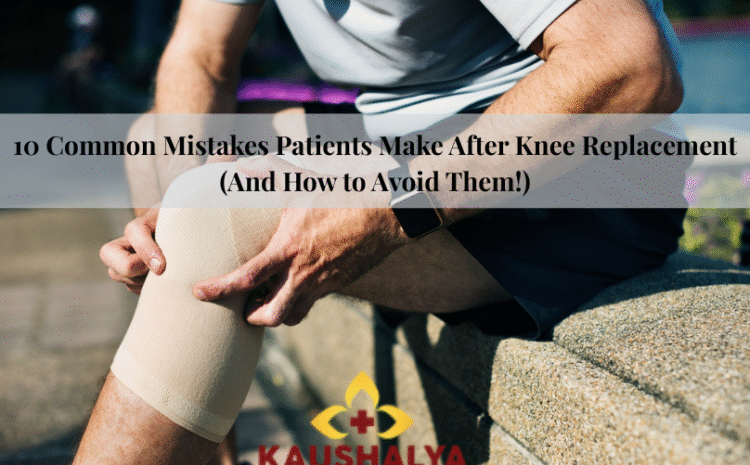
Knee replacement is revolutionary, bringing an end to decades of disabling pain and limitation. Yet recovery in most cases hinges on what happens after the operation. In too many cases, patients overlook critical stages of rehabilitation, delaying healing or creating complications. Familiarity with the most frequent pitfalls will enable you to heal safely, sensibly, and confidently.
1. Skipping or Delaying Physiotherapy Sessions
Most patients make the biggest mistake of not showing up or delaying physiotherapy after knee replacement. Physical therapy works on joint mobility, muscle strengthening, and restoring balance. Delaying it can cause stiffness, limited motion, and lifelong gait trouble.
How to avoid it:
- Follow the physiotherapy regimen as advised by your orthopedic surgeon.
- Perform prescribed exercises daily at home.
- Keep a recovery diary to track progress and generate motivation.
2. Post-Operative Pain Management Neglected
Natural recovery from surgical pain is often under-medicated or over-medicated by most patients. Some patients do not take the medication because of fear of drug dependence, and others take extra doses and suffer side effects.
How to avoid it:
- Take drugs as directed by your physician.
- Place your pain level on regular follow-ups.
- Use non-pharmacologic modalities as well, i.e., icing, breathing, and resting as needed.
3. Walking Too Quickly or Not at All
Other patients also walk too fast by themselves and risk getting hurt or falling. Others walk too little and stiffen and lose their muscle.
How to avoid it:
- Only walk if your physiotherapist says you can walk.
- Walk with a walker or crutches initially to give you stability.
- Walk increasingly each week to slowly pick up speed and distance.
- Your aim should be to move once more slowly and securely, not quickly.
4. Wound Neglect
Neglect of the wound results in infection and delayed healing. The patients often neglect wound cleaning or are unaware of the early warning signs of disease.
How to avoid it:
- Dry and clean the wound.
- Watch out for signs of infection such as swelling, redness, or discharge.
- Follow all the follow-up care regarding wound examination.
- Continue to visit your physician right away if you are having abnormal sensations.
5. Getting Back to Household Activities or Job Too Soon
Some patients, in the race to resume normal activities, undertake heavy activities like weight lifting or climbing stairs too soon. This may cause undue stress to the new joint and interfere with healing.
How to avoid it:
- Avoid lifting something heavy for a minimum of six weeks after surgery.
- Request others to cook, clean, and do housework.
- Return to work progressively as directed by your surgeon.
- Consult the best orthopedic surgeon in Thane for a personalized plan to live a normal life safely.
6. Neglect Of Diet And Fluid Intake
Diet is a crucial area of surgical recovery. Patients fall into poor eating habits soon after, denying their bodies healing nutrients.
How to avoid:
- Consume protein foods (like lentils, paneer, eggs), fiber, and vitamin C.
- Drink plenty of water to improve circulation and joints.
- Avoid foods that are high in sugar and processed.
- Nourishment repairs tissue and forms body strength overall.
7. Ineffective Use of Assistive Devices
Ineffective use of a walking aid or refusal to use one as directed can cause poor posture and imbalance. This places one at greater risk for injury or incorrect healing of joints.
How to avoid it:
- Use crutches, walkers, or canes as directed by your therapist.
- Adjust the height of assistive devices correctly.
- Don’t discontinue their use without consulting your doctor first.
8. Uncontrolled Swelling
Swelling is unavoidable for weeks following surgery, but uncontrolled swelling could be tender and slow the recovery of the muscles. It is a simple mistake for a few patients to sit for extended periods without elevation and cooling.
How to avoid it:
- Lift the leg higher than the heart level several times a day.
- Use an ice pack or cold compression for 15–20 minutes.
- Don’t sit or stand for hours continuously at one sitting.
- Slowing down and gentle handling will minimize swelling quickly.
9. Not Following Up with the Surgeon
Follow-ups allow your surgeon to monitor progress and identify early complications. Most patients, however, quit attending because initial pain fades away, with no regard for significant recovery checks.
How to avoid it:
- Show up on time for all appointments.
- Frank feedback on progress and concerns.
- Share medication problems, physiotherapy, and exercise modifications.
- Scheduled follow-ups keep your recovery on track and identify issues early.
10. Comparing Rate of Recovery with Others
Each patient recovers at his or her own pace according to age, health, and type of surgery. It is tiring to try to keep up with others’ levels of recovery and have unrealistic expectations.
How to avoid it:
- Exercise discretion in preventing gradual improvement relative to others’ recovery levels.
- Pay attention to your own flexibility, balance, and pain control.
- Breathe and be patient; emotional recovery goes hand-in-hand with physical recovery.
When to Call Your Doctor Immediately
If, following surgery, you have any of the following, call your doctor immediately:
- Persistent or increasing pain that does not go away despite pain medication.
- Fever over 100°F or signs of infection.
- Swelling and redness at the incision site or fluid leakage.
- Pain or difficulty breathing (potential indication of clotting).
- Early recognition prevents serious complications and spares your new joint.
Conclusion
Avoiding these ten most common post-surgery mistakes can make your recovery from knee replacement more effective and allow your mobility to come back faster. Listen to your doctor, do your physiotherapy, eat properly, and have faith in healing. All the small, step-by-step measures are towards gaining independence and quality of life.
Experience the difference between professional orthopedic treatment and the latest robotic knee replacement at Kaushalya Hospital, Thane.
Book today for quicker, safer recovery!

